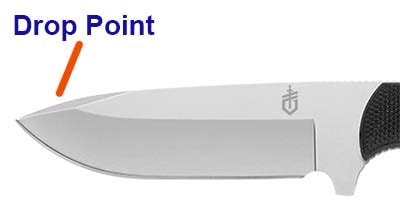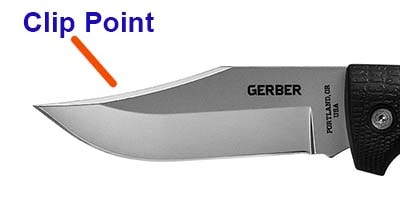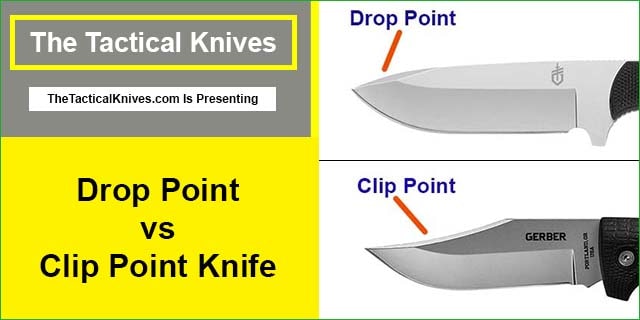Whether you are a dedicated outdoors enthusiast, a seasonal hunter, or a skilled woodcarver, choosing the best knife for you is essential. There are two blade shapes which are most common today: the drop-point knife and the clip-point knife. But what is the difference between these two styles, and which style is best for your activities?
What Is A Drop Point Blade?
The defining feature of this knife is as the name suggests – the spine of the blade drops down into a convex curve, creating a wider belly and broader tip. These knives are typically thicker than clip-point knives, meaning they are studier. Drop point blades are suited for cutting, skinning, throwing, and prying.

What Is A Clip Point Blade?
Rather than the wider, convex design of the drop point blade, the spine of the clip point knife features a straight or concave edge at the end of the blade, creating a much finer tip. The blade is often thinner and is ideal for carving, slicing, and puncturing.

Design/Aesthetics/Functions Comparison
The main difference between these two blades is the design of the spine. While the clip point blade is seen as aesthetically superior due to its traditional and stylish curved design and sharp point, the drop point is viewed more as a tool, with a simpler and sturdier blade. Apparent by its wider belly and thicker point, the drop point is designed for heavy-duty applications such as prying and skinning. The clip point is sharper and exceeds at making clean, deep cuts. It is convenient for cutting ropes and small branches and carving detailed designs.
Durability/Strength Comparison
Due to the sturdy design of the drop point blade, it is able to endure much more intense applications than the clip point. The combination of the wider blade and thicker, shorter point makes for a more versatile and durable knife. The drop point knife can be used for tasks that require immense force or harsh conditions, which is why it is often regarded as a reliable outdoor camping tool. The clip point has a thinner blade and a longer point. It is much more susceptible to breaking under pressure and is not built to withstand a lot of stress.
Point Control Comparison
The thin, needle-point blade of the clip point makes it harder to control. Though a scalpel-style grip can be achieved by holding a finger along the concave clip, this technique is more useful for projects that require a lot of precision. The drop point’s wider tip ensures there is a lesser chance of unintentionally puncturing something you do not intend to cut, which is handy for skinning hides. Since the point of the drop blade is less defined, it is much easier to control.
Precision Comparison
The drop point’s thick and sturdy nature makes it less than ideal for precise cuts. Due to the fuller blade, attempting to use the drop point for detailed projects can end rather messily. Thus, the clip point’s fine point and thinner blade make it the obvious choice for ease of precision.
Maintenance Comparison
Both blade shapes require proper maintenance to keep them in good condition and ensure their longevity. These blades require regular sharpening to keep its edge in good condition. The drop point blade can be a bit more difficult to sharpen and maintain due to its long and wide curve. The clip point blade also requires regular sharpening and cleaning to maintain its precise edge and prevent corrosion. As the clip point is thinner and less durable than the drop point, it may require extra care to keep it in pristine condition.
Uses Comparison
The drop point blade and clip point blade are both popular choices among hunters and outdoors enthusiasts. Both blades offer a multitude of uses, from carving, stabbing, skinning, and even self-defence. The clip point blade’s light and slick design make it ideal for slicing and slashing, while the drop point’s durability makes it ideal for heavy-duty everyday use.
For Hunting Purpose
When it comes to choosing the perfect blade for a hunting trip, drop point and clip point blades are both great options to consider. Drop point blades are the ultimate workhorses. Their strong convex curve makes them perfect for tough tasks like skinning and field dressing big game. These blades are also very versatile, so they can take on all sorts of hunting jobs with ease. Clip point blades are the masters of precision, and their curve at the top makes them perfect for delicate tasks such as gutting small game or preparing bait. While both blade shapes have their own strengths, many hunters prefer drop point knives due to their versatility and ability to handle a wide range of tasks. Their durability also makes them a reliable choice.
For Bushcraft Purpose
In terms of bushcraft, both blade styles offer unique advantages that make them well-suited to different types of tasks. The clip point blade allows for precision cuts, making it perfect for fine carving or preparing bait. A drop point blade’s stronger tip and a convex curve provide more surface area for slicing. This makes it ideal for tasks like carving, food preparation, and general outdoor activities. Ultimately, the best choice will depend on the specific needs of the user and the types of tasks they will be undertaking. Drop point knives are typically preferred for bush crafting due to their handiness, sturdiness, and ability to survive the outdoors.
For Survival Purpose
When it comes to survival, having a versatile blade is crucial. Drop point and clip point blades are both great options, but a drop point blade is like a Swiss army knife; it can handle various tasks, from building shelter to preparing food, and it can even be used as a self-defence tool. Its sturdiness makes it more reliable to handle excessive and rough usage. A clip point blade is great for cutting ropes and slicing through thick materials with ease. Though it is more likely to break, it makes puncturing and slashing much easier. Both types of blades have their own advantages, but many survivalists prefer a drop point blade because it can handle a wide range of tasks, is versatile, and is dependable. When it comes to survival, a drop point blade is a safer bet.
For Camping Purpose
Drop point blades are great for carving wood into functional objects such as tent stakes or pots, and for building shelters. Their versatile design allows them to handle everything from rough chopping to delicate carving with ease, and are known for their durability and ability to withstand rugged outdoor conditions. On the other hand, clip point blades are perfect for carving intricate designs into wood or preparing bait for fishing. They are especially well-suited for smaller camping operations that require more precision. While both blade shapes have their own advantages, many campers prefer drop point knives due to their versatility and ability to handle a wide range of tasks around the campsite, including those related to shelter and wood carving. So, if you want a blade that can help you survive in the wilderness and will last for many camping trips to come, go for the drop point.
For Combat Purpose
Clip point blades have a needle-point tip that excels at tasks such as stabbing and slashing through animal hides or thick fabric. The sharp blade of a clip point is especially useful for combat situations because it allows for precise strikes that can disable an attacker with minimal effort. Though drop point blades are also great for combat, they require a greater effort to wield due to their thicker blade and wider point. Clip points are ideal for combat due to their stealthy design and ability to deliver precise, disabling strikes in dangerous situations.
For Self Defense Purpose
With the clip point’s sharp tip and ability to deliver targeted strikes to vulnerable areas, these knives are the perfect tool for self-defence. They are particularly effective in delivering piercing strikes to vital organs, making them a formidable weapon. The lightweight and easy-to-handle design of a clip point knife also make it convenient to keep on hand at all times, making it ready when you need it. Drop point knives have shorter and less pointed tips in comparison, making them less suitable for piercing skin. This can be a disadvantage when using it for self-defence.
For Tactical Purpose
Tactical operations require a knife with versatile qualities, and both drop point and clip point blades have their own unique strengths. For tasks such as prying or batoning or anything that requires excessive amounts of stress, drop point blades are more reliable. In terms of accurate and convenient slices, stabs, or piercings, clip point knives are ideal. Both blade shapes have their own advantages, and it heavily depends on the situation to pick the best knife.
Versatility Comparison
Drop point blades are most known for their versatility. This blade shape is well-suited for a wide range of tasks, due to its wider and sturdier build. The larger curve on the drop point blade also allows for more control when making large cuts. Clip point blades have a finer point for piercing and detail work. This blade shape may be better suited for more precise cuts but is not recommended to use for other rough or demanding tasks. While both blade shapes have their own advantages, many people prefer drop point knives due to their versatility and ability to handle a wide range of tasks with ease. In the end, the choice between a drop point or clip point blade will depend on the specific needs and preferences of its user, but in terms of versatility, a drop point blade is often the better choice.
Drop Point Vs Clip Point Blade – Which One to Choose and Why?
When it comes to selecting the right blade, it’s all about finding the perfect match for your needs and preferences. Drop point and clip point are both great options, but they offer different things. A drop point knife is a real jack-of-all-trades. It’s perfect for slicing, chopping, and carving, so it’s great for general outdoor activities like hunting, bushcraft, and even cooking. The convex curve from the spine to the tip gives it a strong tip and plenty of surface area for slicing.
On the other hand, clip point blades are more specialized. They have a concave curve which makes them great for precision tasks like gutting small game, preparing bait, and making intricate cuts. They’re also popular for self-defence and tactical operations, because of their ability to deliver deep and precise strikes. However, clip point knives are not as versatile as drop point knives and are not as good for everyday use.
It’s all about what you’re using it for. If you’re just looking for a solid, reliable knife to have around, then a drop point knife is probably your best bet. But, if you’re a survivalist, hunter, or you’re in the military, then a clip point knife is a perfect choice.
Final Verdict
Both the drop point and clip point are excellent choices for outdoor, self-defence, and other tactical uses. They each have their own unique strengths and are able to accomplish a variety of tasks. However, if I had to choose one, the drop point blade is the most versatile and multifunctional of the two, making it highly recommended as a general-use knife.
